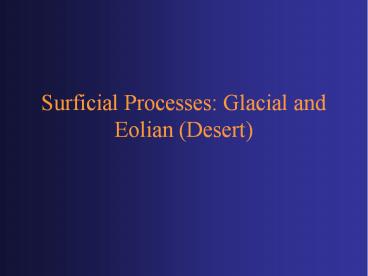Surficial Processes: Glacial and Eolian (Desert) - PowerPoint PPT Presentation
Title:
Surficial Processes: Glacial and Eolian (Desert)
Description:
Title: Surficial Processes: Glacial and Eolian (Desert) Author: A satisfied Microsoft Office User Last modified by: H0005564 Created Date: 1/6/2001 8:17:56 PM – PowerPoint PPT presentation
Number of Views:168
Avg rating:3.0/5.0
Title: Surficial Processes: Glacial and Eolian (Desert)
1
Surficial Processes Glacial and Eolian (Desert)
2
Environmental Implications of Glacial and Eolian
Processes
- Glacial
- Active processes generally less important than
resulting materials and landforms - Main exception Permafrost
- Explain?
- Eolian Wind/Deserts
- Active process and resulting materials are
important - Explain?
3
Environmental Implications of Glacial and Desert
Systems Examples
- Processes Important for land use
- Landforms Physical characteristics important for
human use (e.g., stability) - Represent response (feedback) mechanisms to
climatic changes - Evidence/(Indicators of environmental change) for
past and future changes in the global environment
e.g., climate - Coupled with other processes (e.g., plate
tectonic, volcanism, atmospheric) affects other
systems and processes (e.g., biogeochemical,
surficial, etc.)
4
Surficial Processes and Landforms Associated with
Ice and Wind
- Landforms environmentally sensitive areas
- Coastal, desert, arctic, subarctic
- Effects of ice and wind on rocks and landforms
- Environmental problems associated with wind and
ice
5
Ice Glaciation
- Glaciers (Land-bound) masses of moving ice
- Cover about 10 of earth
- Accounts for lt2 of earths water (w/ other forms
of ice) - Types
- Continental Cover large areas of land
- Alpine Confined to mountain valleys
- Both types are associated with distinctive
erosional and depositional processes and
resulting landform features - Permafrost
6
Continental Glaciation Landforms
- Erosional
- Expansive areas of exposed, eroded, flattened,
polished bedrock - Kettles/pothole lakes
- Depositional Expansive areas/fronts of deposition
- Morain highly variable, loose, jumbles of eroded
material (typically unstable?) - Drumlins
- Eratics
- Loess (windblown, very fine glacial silt)
7
(No Transcript)
8
Drumlin
9
(No Transcript)
10
Extent of glacial ice sheet in North America
11
(No Transcript)
12
(No Transcript)
13
Alpine Glacial Landforms
- Erosional
- U-Shaped valleys
- Fjiords
- Horns, cirques, aretes
- Depositional
- Various types of till/morain
14
(No Transcript)
15
(No Transcript)
16
(No Transcript)
17
(No Transcript)
18
(No Transcript)
19
(No Transcript)
20
Permafrost
- Permafrost Permanently frozen ground
- Underlies 20 of worlds land area
- Types
- Continuous Predominantly frozen all the time
- Discontinuous Areas of thawed ground in areas of
predominantly frozen ground - Potential for perturbation from human activities
- Examples?
21
(No Transcript)
22
Environmental Significance
- Building/engineering challenges associated with
- Glacial deposits landforms
- Permafrost
- Environmental implications of man-made
perturbations in permafrost areas - Distribution physical characteristics of areas
affected by glaciation - Till/Morain vs. bedrock
- Groundwater implications
- Episodic effects
- Hubbard Glacier example
23
Arid Environments
24
Wind
- Simultaneous erosion and deposition
- Dunes
- Mass transport/deposition of sand close to the
ground - Dune type dependent on wind characteristics
- Physical Characteristics Loose, porous, variable
- Negative implications for flora/agriculture??
- Loess
- Fine-grained material carried up to thousands of
meters in altitude - Associated with expansive Dust storms (100s km
in diam.) - Found in specific geographic locations
- Highly susceptible to erosion
- Variable stability (e.g., for foundations, etc.)
- Can be good for agriculture
25
(No Transcript)
26
- Dune characteristics vary with conditions
- Recognition/appreciation is important
- Memorization of the types details isnt (for
this class)
27
(No Transcript)
28
Environmental Implications of Eolean Deposits
Processes
- Loess hazardous foundations
- Problems of migrating sand, silt (e.g., expensive
construction maintenance for highways,
buildings, hydraulic structures - Implications for geography, climate in geologic
past - Implications of desertification, global warming
or cooling on the environment (later)
29
Section Summary
- Recent (geologically) continental glaciation
produced a variety of earth materials - Widespread
- have implications for planning, design, building
- Permafrost
- environmentally sensitive
- Requires specialized engineering to prevent
adverse effects - Windblown sand, silt, dust
- Widespread
- Concentrated in specific areas (coasts, interior,
rivers) - Loess potential foundation problems/agricultural
benefits - Sand Dunes (Migrating Stabilized)
- Implications for construction maintenance of
highways, buildings, hydraulic structures
30
Other Things to Remember
- Erosional AND depositional implications of
glacial and eolian processes - Some of the more important examples
- Landforms
- Physical properties of e.g., till, loess
- Where do these types of materials occur
(geographic distribution) - Recognition (general) of landforms/materials
- Environmental implication for
- The past
- The present
- The future
31
(No Transcript)































